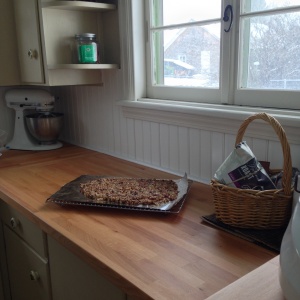“When we come to the Table in Communion
we are called to take time to be together….
It takes time:
time to serve the elements of The Meal, time to stand in line, time to think and pray, time to prepare to eat together, and time to remember how we got there.”from Keeping the Feast: Metaphors for the Meal
by Milton Brasher-Cunningham
Of course, the holiday season just past is supposed to be about this taking slow time together. I’m sure it works that way for you, but we haven’t mastered the trick yet. Despite our detailed planning this Advent, and careful simplifying of life — we still found ourselves coming to the end of 2014 rushing to get everything in. Rushing to be fully present to everything. Rushing to slow down.
Communion the first Sunday of the new year is a brilliant idea. It gave me a place to take all the ways I failed to pay attention, listen, be still — and start over right there.
Making my own yogurt is another act I can take to reset myself. While it’s not exactly convenient, it is very easy. It just requires attention to a few details and then several hours of waiting.
Why in the world would you want to make your own yogurt? For one, it’s a lot less expensive. You can make two quarts of organic plain yogurt for the same price you’d pay for one quart of non-organic. But more than that, the process of making yogurt — whisking a pot of creamy liquid, smelling milky steam, testing the temperature along the way — is remarkably soothing if you are willing to slow down and give it your full attention. And eating the yogurt we’ve made ourselves has nourished us first thing in the morning with a lot of joy.
INGREDIENTS
1/2 gallon of 2% milk
1/2 cup of plain (unflavored) yogurt
INSTRUCTIONS
Over a medium high burner, heat the 1/2 gallon of milk in a heavy pot until it’s about 190 degrees (or just shy of boiling), stirring occasionally to prevent it from scalding on the bottom. This can take 20-25 minutes, depending on the shape of your pot.
Let it cool to about 110 degrees (to speed the process, you can set the pot in a sink half full of cold water and ice packs). If a skin forms on top, just skim it off.
When the milk is at 110 degrees, dip out a 1 cup and mix in the 1/2 cup of plain yogurt. Whisk together, then pour the mixture into the warm milk and stir.
Pour the warm milk into two 1 quart containers (wide mouth mason jars work well, as do plastic container with good lids), cover and then set in a picnic cooler packed around with dish towels. Drop in a heating pad turned to its lowest setting. Let it go for at least 4 hours, but up to 24 hours is just fine. The longer it sits, the more probiotic-y (and the more tart) the finished yogurt.
Alternately, place the full pot of warmed milk, covered, in an oven pre-warmed to 200 degrees. Turn the oven off and keep the door closed for 4 to 24 hours.
Remove from the warmth and refrigerate until ready to eat. Sweeten each serving with honey and a bit of vanilla extract, or add fresh fruit or fruit preserves.
*NOTE: The healthy bacteria that turns milk into yogurt flourish in an environment that stays a temperature between 98-115 degrees. Heating the milk to near boiling first kills off any undesirable bacteria, then the good probiotics are added when the temperature is friendly to their growth. A cooler “culturing” temperature just means the yogurt will thicken more slowly. A warmer temperature may kill the probiotics altogether and just leave you with hot milk.
Making yogurt is a gentle, forgiving process. And who doesn’t need that in January?
